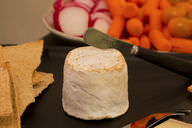3.11 原子民主思想
Section outline
-
The man shown above has been called the “laughing philosopher” because of his cheerful disposition. He certainly looks cheerful in this picture. Why is a philosopher featured in a science text? He made an amazing contribution to science, although it was ridiculed by others and then ignored for more than 2000 years. His name was Democritus, and he introduced the idea of the as the basic building block of all matter.
::上述人之所以被称为“笑哲学家 ” , 是因为他的喜好。 他当然在这张图中看起来很开心。 为什么哲学家在科学文本中占有一席之地? 他为科学做出了令人惊叹的贡献,尽管科学被他人嘲弄,后来又被忽略了2000多年。 他的名字叫“民主 ” ( Democricitus ) , 并引入了“作为所有事物基本基石”的概念。Cutting the Cheese
::切起司Democritus lived in Greece from about 460 to 370 B.C.E. Like many other ancient Greek philosophers, he spent a lot of time wondering about the natural world. Democritus wondered, for example, what would happen if you cut a chunk of matter—such as a piece of cheese into smaller and smaller pieces. He thought that a point would be reached at which the cheese could not be cut into still smaller pieces. He called these pieces atomos , which means “uncuttable” in Greek. This is where the modern term atom comes from.
::民主主义人士在公元前460年到370年生活在希腊,从公元前460年到公元前370年,与许多其他古希腊哲学家一样,他花了很多时间思考自然世界。例如,民主主义人士想知道,如果你把一块物质——比如一块奶酪切成小块——将会发生什么。他认为,一个切不切入奶酪切成小块的点将达到一个不能切成小块的点。他称这些片子为希腊语“不可切割 ” 。 这就是现代原子的起源。How many times could you cut this piece of cheese in half? How small would the smallest pieces be?
::你能把这块奶酪切成两半多少次?Just a Guess
::猜一猜一猜Democritus’ idea of the atom has been called “the best guess in antiquity.” That’s because it was correct in many ways, yet it was based on pure speculation. It really was just a guess. Here’s what Democritus thought about the atom:
::民主主义对原子的观念被称作“古代最好的猜测 ” 。 这是因为它在许多方面是正确的,但它是基于纯粹的猜测。 这其实只是一个猜测。 民主主义对原子的看法如下:-
All matter consists of atoms, which cannot be further subdivided into smaller particles.
::所有物质由原子组成,不能进一步细分为较小的粒子。 -
Atoms are extremely small—too small to see.
::原子非常小,太小,看不见。 -
Atoms are
particles that are indestructible.
::原子是不可摧毁的粒子 -
Atoms are separated from one another by emptiness, or “void.”
::原子因空虚或“避免”而彼此分离。
Q: How are Democritus’s ideas about atoms similar to modern ideas about atoms?
::问:民主党对原子的看法如何与现代对原子的看法相似?A: Modern ideas agree that all matter is made up of extremely small building blocks called atoms.
::A:现代思想一致认为,所有问题都由称为原子的极小的构件组成。Q: How are Democritus’s ideas different from modern ideas?
::问:民主派的思想与现代思想有何不同?A: Although atoms are extremely small, it is now possible to see them with very powerful microscopes. Atoms also aren’t the solid, uncuttable particles Democritus thought. Instead, they consist of several kinds of smaller, simpler particles as well as a lot of empty space. In addition, atoms aren’t really indestructible because they can be changed to other forms of matter or .
::A:虽然原子非常小,但现在可以用非常强大的显微镜来观察它们。 原子也不是坚固的、不可削减的民主主义粒子。 相反,原子由几种更小、更简单的粒子以及许多空空空间组成。 此外,原子并不是不可摧毁的,因为它们可以被改变为其他物质或形式。Keep on Moving
::继续前进Did you ever notice dust motes moving in still air where a beam of sunlight passes through it? You can see an example in the forest scene in the Figure . This sort of gave Democritus the idea that atoms are in constant, random motion. If this were true, Democritus thought, then atoms must always be bumping into each other. When they do, he surmised, they either bounce apart or stick together to form clumps of atoms. Eventually, the clumps could grow big enough to be visible matter.
::你是否注意到过沙尘暴在静气中飘动 阳光的光束穿过它?你可以看到图中森林的一例。这样让民主党认为原子是恒定的随机运动。如果这是真的,民主党认为,那么原子必须总是相撞。当它们发生时,他推测,它们要么分开,要么聚在一起形成原子块。最终,这些块块会长得足够大,成为可见的物质。Dust motes dance in a beam of sunlight.
::尘土在阳光的光束中跳舞Q: Which modern theory of matter is similar to Democritus’ ideas about the motion of atoms?
::问:什么现代物质理论与民主党关于原子运动的想法相似?A: The modern is remarkably similar to Democritus’ ideas about the motion of atoms. According to this theory, atoms of matter are in constant random motion. This motion is greater in than in , and it is greater in liquids than in solids. But even in solids, atoms are constantly vibrating in place.
::问题:现代与民主党关于原子运动的想法非常相似。 根据这一理论,原子在不断随机运动中。 这一运动在液体中比在液体中大,在液体中比在固体中要大。 但即使在固体中,原子也在不断振动。Why Matter Varies
::为什么案件变数Democritus thought that different kinds of matter vary because of the size, shape, and arrangement of their atoms. For example, he suggested that sweet substances are made of smooth atoms and bitter substances are made of sharp atoms. He speculated that atoms of liquids are slippery, which allows them to slide over each other and liquids to flow. Atoms of solids, in contrast, stick together, so they cannot move apart. Differences in the of matter, he argued, could be explained by the closeness of atoms. Atoms of lighter matter, he thought, were more spread out and separated by more empty space.
::民主主义认为,不同种类的物质因其原子的大小、形状和安排而不同。例如,他建议甜物质由光滑原子制成,苦物质由尖锐原子制成。他推测,液体原子是滑的,可以滑动,从而相互滑动,液体流动。相反,固体原子是粘合在一起的,因此它们不能分开。他认为,物质上的差别可以用原子的近距离来解释。他认为,较轻物质的原子在更空的空隙中分布和分离的更多。Q: Democritus thought that different kinds of atoms make up different types of matter. How is this similar to modern ideas about atoms?
::问题:民主党认为,不同种类的原子构成不同种类的物质。 这与现代的原子概念有何相似之处?A: The modern view is that atoms of different differ in their numbers of and electrons and this gives them different physical and chemical properties.
::A:现代观点是,原子的数量和电子不同,原子的物理和化学特性也不同。That’s Ridiculous!
::这太荒谬了!Democritus was an important philosopher, but he was less influential than another Greek philosopher named Aristotle, who lived about 100 years after Democritus. Aristotle rejected Democritus’ idea of the atom. In fact, Aristotle thought the idea was ridiculous. Unfortunately, Aristotle’s opinion was accepted for more than 2000 years, and Democritus’ idea was more or less forgotten. However, the idea of the atom was revived around 1800 by the English scientist John Dalton. Dalton developed an entire theory about the atom, much of which is still accepted today. He based his theory on experimental evidence, not on lucky guesses.
::民主是一个重要的哲学家,但是他比另一个希腊哲学家亚里士多德(亚里士多德,亚里士多德在民主后生活了约100年 ) , 他比另一个希腊哲学家亚里士多德(亚里士多德)更没有影响力。 亚里士多德拒绝民主党对原子的看法。 事实上,亚里士多德认为这个想法是荒谬的。 不幸的是,亚里士多德的观点被接受超过2000年,而民主党的想法被多少忘记了。 但是,英国科学家约翰·道尔顿(John Dalton)在1800年左右恢复了原子的观念。 道尔顿发展了整个原子理论,其中的大部分今天仍然被接受。 他以实验证据而不是幸运的猜测为依据的理论。Summary
::摘要-
Around 400 B.C.E., the Greek philosopher Democritus introduced the idea of the atom as the basic building block matter.
::公元前400年左右 希腊哲学家民主党 提出原子是基本建筑材料 -
Democritus thought that atoms are tiny, uncuttable, solid particles that are surrounded by empty space and constantly moving at random.
::民主主义认为原子是微小的, 不可侵蚀的,固态的粒子, 周围都是空旷的空间, 并且不断随意移动。 -
Democritus surmised that different kinds of matter consist of different types or arrangements of atoms.
::民主党推测,不同种类的问题包括不同种类的原子或安排。
Review
::回顾-
Who was Democritus?
::民主党是谁? -
How did Democritus reason for the existence of atoms?
::民主党如何解释原子的存在? -
How did Democritus describe atoms?
::民主党如何描述原子? -
Discuss how well Democritus’ ideas about atoms have withstood the test of time.
::讨论民主党关于原子的想法如何经受了时间的考验。 -
Iron and lead are both metals, but iron is much harder than lead. How do you think Democritus might have explained this difference?
::铁和铅都是金属,但铁比铅难得多。 你认为民主党会如何解释这种差异?
Explore More
::探索更多Watch the video below and answer the questions that follow.
::看下面的录像,回答下面的问题。-
Develop a hypothesis to explain the results of the two experiments.
::提出一个假设来解释这两个实验的结果。 -
Relate your hypothesis to Democritus’s ideas about atoms.
::将你的假设与民主党关于原子的想法联系起来。
Resources
::资源 -
All matter consists of atoms, which cannot be further subdivided into smaller particles.


